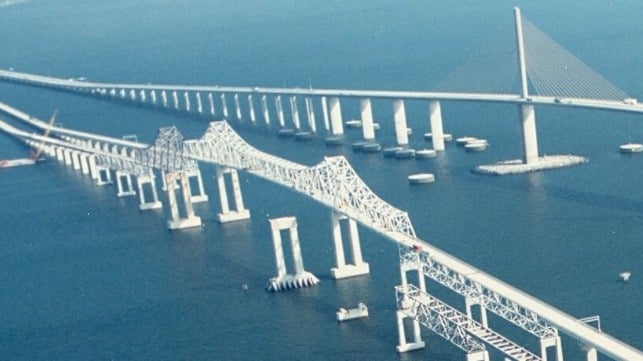I think boats should come with crumple zones.
Well, I think that ships should be built so the front doesn’t fall off.
Stranger
Well yeah, but the Kurki was hit by a wave. Chance in a million.
Do they get waves in the Cheasapeake Bay?
Only in the water.
Stranger
For contrast between old and new protection measures, here’s a side-by-side the old and new Tampa Bay Sunshine Skyway Bridge, whose southbound span got taken out in 1980 when rammed by a vessel (considerably smaller than the Dali), and next to it the new one, in the time before the uncollapsed parts of the old one were completely removed. Notice the size and number of the dolphins and the size of the artificial island barrier around the towers on the new bridge.
It seems negligent that Tampa Bay and Baltimore didn’t put in protection for their bridges until an accident happened. Surely they could guess that shit happens and better to be proactive.
No doubt there are many other such bridges at risk. Hopefully this is a wake-up call for them to put in protection but I won’t hold my breath they will do so.
It costs an awful lot of money to be proactive. “Hey, it hasn’t happened yet - we’ll worry about if it ever does.” I mean that is most places, most situations, most of the time.
A comparison can be made to seismic retrofitting in California which seems to get fresh emphasis after every large earthquake and those happen a lot more often than a container ship taking down a major commuter bridge and blockading a port.
Seems penny wise and pound foolish.
Especially for a port which is making loads of money. It is in their interest to keep that economic engine running smoothly. How much would bridge defense have cost them? How much will they lose from this accident?
Of course it is. Welcome to the world ![]() .
.
I’ve been bitching about penny wise, pound foolish at my job for over thirty years. Everybody nods sagely and agrees and nothing ever changes. It is all about the immediate fiscal year and not costs/hassles over five or ten or twenty.
Four minutes is not much time for an ultra massive ship to change course or slow down. But it is ample time for such a ship to transmography into a harmless stuffed tiger. Either they could not find a suitable cardboard box or they lacked the specific expertise or personnel, which is surprising.
Well, I think that boats should be built so that they don’t turn into bananas.
Stranger
The bridge protection on the Key Bridge look, to my eye, to be more recent than the bridge itself. The islands look like the islands in @JRDelirious’s picture of the “new” Tampa Bay Sunshine Skyway Bridge, not from the same period as the bridge.
Too far out, and the ship ducked inside to collect the bridge, but maybe the bridge protection had already been upgraded?
I do? Where?
My claim is not that tugs are the solution. My claim is that there is some point in time at which a solution is possible. When, I don’t know. Maybe it’s five minutes, maybe it’s ten minutes, maybe it’s an hour. And what the solution is, I don’t know either: Maybe it’s tugboats, maybe it’s anchors, maybe it’s letting the ship drift to a halt, maybe it’s activating back-up systems on the ship.
But whatever that solution is, and whenever, ships should be operated in a way that the solution is possible if needed. That’s the standard we expect of all other vehicles.
I’m confident that the solution we are looking for has nothing to do with the vagaries of thousands of ships and their crews. I’m astounded that so many of these bridges were built with no thought to passive defenses like breakwaters or dolphins. The stability of overpasses isn’t left to the diligence of motorists. Why is it different for bridges and ships?
Except that the Key bridge did have / does have dolphins, which the ship got past correctly.
Here is the point that you should have written “We’ll cross that bridge when we come to it.”.
There was plenty of passive defenses at the Key bridge. For the design standards in effect in the early 70s when it was designed. Which standards required fending off 1960s era ships.
What hasn’t happened anywhere, is restricting ships in harbors to the size the nearby bridges were designed to fend off, nor have we been upgrading bridge protections continuously to account for the ever larger and heavier ships that do use those ports.
In that sense it’s no different than the many highways built 10 or 40 yeas ago that now have fewer lanes than are required to keep traffic flowing fast all the time. It’s a never ending battle for funding to keep expanding roads and collectively the roads are not keeping up with demand. Bridge defenses are the same functional problem.
We simply have not improved our total national infrastructure at anywhere near the rate that demands for it, and threats to it, have grown.
If they didn’t have a skilled transmographer, things might have turned out worse than they did… more than twice as bad…
What incredible insight you have brought to the discussion.
Stranger


